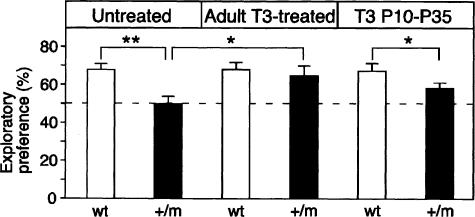Figure 3.
Normalization of visual recognition memory by adult T3 treatment as measured by the novel object recognition task. TRα1 mutant mice (n = 12) showed a reduced exploratory preference in the object recognition task compared with wild-type control mice (n = 9). Mutant untreated mice displayed a memory impairment in this task since the discrimination ratio did not differ from the chance level [t(11) = 12.7, P < 0.0001]. TRα1+/m (n = 5) mice treated with T3 as adults showed a similar preference for the new object as wild-type treated mice (n = 8) and performed significantly better in this task than mutant untreated mice. Injection of T3 during P10-P35 failed to improve object recognition memory in TRα1+/m (n = 8) compared with wild-type (n = 6) mice. The dashed line represents equal exploration of the novel and familiar objects (50%). Data were analyzed by means of a two-way (“genotype” × “T3 treatment”) ANOVA. Data are presented as means ± SEMs; (★) P < 0.05; (★★) P < 0.01; (★★★) P < 0.001.

